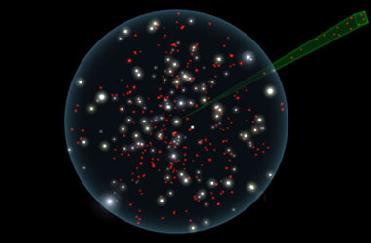
This artist's concept shows simulated data predicting the hundreds of failed stars, or brown dwarfs that NASA's Wide-field Infrared Survey Explorer (WISE) is expected to add to the population of known stars in our solar neighborhood: AMNH/UCB/NASA/JPL-Caltech photo
NEW DELHI (BNS): Astronomers have uncovered what appear to be 14 of the coldest stars known in the universe.
These failed stars, called brown dwarfs, are so cold and faint that they are impossible to see with current visible-light telescopes. However, Spitzer's infrared vision was able to pick out their feeble glow.
The new objects are between the temperatures of about 450 Kelvin to 600 Kelvin (350 to 620 degrees Fahrenheit). As far as stars go, this is bitter cold -- as cold, in some cases, as planets around other stars.
NASA's Wide-field Infrared Survey Explorer (WISE) mission, which is up scanning the entire sky now in infrared wavelengths, is expected to find hundreds of objects of a similarly chilly disposition, if not even colder.
WISE is searching a volume of space 40 times larger than that sampled in the recent Spitzer study, which concentrated on a region in the constellation Bo�tes. The Spitzer mission is designed to look at targeted
patches of sky in detail, while WISE is combing the whole sky.
"WISE is looking everywhere, so the coolest brown dwarfs are going to pop up all around us," said Peter Eisenhardt, the WISE project scientist at NASA's Jet Propulsion Laboratory, Pasadena, California., and lead author of a recent paper in the Astronomical Journal on the Spitzer discoveries.
Most of the new brown dwarfs found by Spitzer are thought to belong to the coolest known class of brown dwarfs, called T dwarfs, which are defined as being less than about 1,500 Kelvin (2,240 degrees Fahrenheit).
One of the objects appears to be so cold that it may even be a long-sought Y dwarf -- a proposed class of even colder stars. The T and Y classes are part of a larger system categorizing all stars; for example, the hottest, most massive stars are O stars; our sun is a G star.
The 14 objects found by Spitzer are hundreds of light-years away -- too far away and faint for ground-based telescopes to see and confirm with a method called spectroscopy. But their presence implies that there are a hundred or more within only 25 light-years of our sun.
Because WISE is looking everywhere, it will find these missing orbs, which will be close enough to confirm with spectroscopy. It is possible that WISE will even find more brown dwarfs within 25-light years of the sun than the number of stars known to exist in this space.
"WISE is going to transform our view of the solar neighborhood," said Eisenhardt. We'll be studying these new neighbors in minute detail -- they may contain the nearest planetary system to our own."
 Previous Article
Previous Article












The Indian Air Force, in its flight trials evaluation report submitted before the Defence Ministry l..
view articleAn insight into the Medium Multi-Role Combat Aircraft competition...
view articleSky enthusiasts can now spot the International Space Station (ISS) commanded by Indian-American astr..
view article